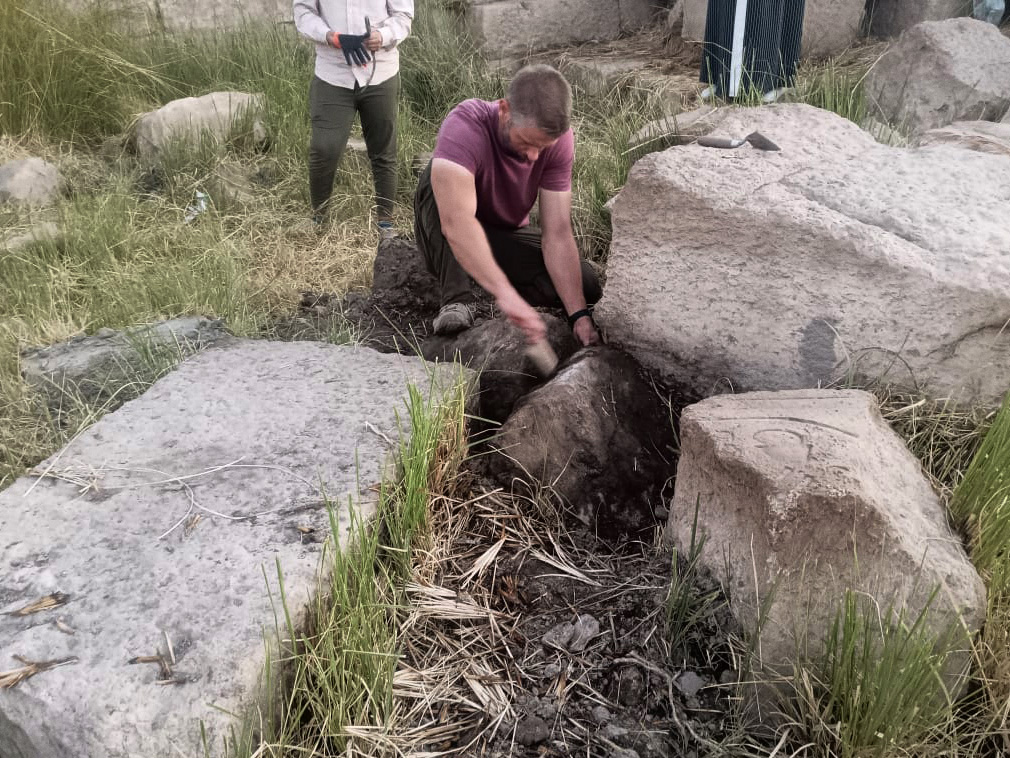Researcher ERC DiverseNile Project, WP 1 (settlements)

Carl G. Elkins worked for over 10 years as a digital artist in fashion and advertising for global brands in Europe, North America and Asia, during which time he studied Egyptology at the University of Manchester. He holds an MA in Egyptology from the LMU Munich and teaches Middle Egyptian at the LMU and digital reconstruction at the University of Applied Sciences and Arts (HAWK) in Hildesheim. He is lead researcher of a joint LMU Munich, HAWK Hildesheim and Minia University project for the conservation, restoration and excavation of the Roman Period Temple of Domitian in Hermopolis Magna (El-Ashmunein). His broader research focus is on ancient Egyptian art and architecture, the former focusing primarily on ancient Egyptian statues.
Digital reconstruction plays a central role in Carl’s work, which leverages cutting-edge 3D rendering and interactive simulation technologies to create immersive, data-driven reconstructions of urban environments that offer unique insights into materiality and lived experience. He is working on DiverseNile’s Work Package 1 “The variability of domestic architecture in the Attab to Ferka region”, using the project’s scan data to help (re)interpret buildings within both their urban contexts and the Nubian landscape by means of photorealistic reconstruction.
Main Areas of Research
Domestic and sacral architecture, urban environments, Ancient Egyptian art, ancient principles of design and composition, Egyptian temples of the Graeco-Roman Period, Ptolemaic hieroglyphs, wordplay in ancient Egyptian ritual texts
Education
2022–2025 MA in Egyptology, LMU Munich
2019–2021 Diploma in Egyptology, University of Manchester
2013–2018 Certificate in Egyptology, University of Manchester
Career History
Since 2025 Researcher for the ERC DiverseNile Project, LMU Munich
Since 2021 Independent researcher and freelance reconstruction artist for museums, Munich
2020–2022 Freelance digital artist, Munich
2009–2019 Head of Postproduction, Studio Mierswa-Kluska, Munich
Projects
Since 2024 Lead Researcher of the conservation, restoration and excavation of the Temple of Domitian in Hermopolis Magna (El-Ashmunein) as part of the German Academic Exchange Service (DAAD) “Conservators & Archaeologists” Project, LMU Munich, HAWK Hildesheim, Minia University
2024 Contributor and teaching staff in the DAAD “Conservators & Archaeologists” Project, LMU Munich, HAWK Hildesheim, Minia University, under the DAAD’s “Higher Education Dialogue with the Muslim World” programme
2023–2024 Contributor and teaching staff in the DAAD “Explore & Protect” Project, LMU Munich, HAWK Hildesheim, Minia University, Yarmouk University, University of Jordan, under the DAAD’s “Ta’ziz Partnership” programme
Select Publications
In preparation:
C. Bayer, C.G. Elkins, S. Kielau und R. Schulz (eds), Hermopolis Magna: Preserving and transforming traditions. Proceedings of the international conference held in Hildesheim, 11–13 August 2022 (ÄAT)
F. Hoffmann, C.G. Elkins, “Reconstruction of Egyptian Temples Based on Hieroglyphic Inscriptions from Hermopolis Magna”. In C. Bayer, C.G. Elkins, S. Kielau und R. Schulz (eds) Hermopolis Magna: Preserving and transforming traditions. Proceedings of the international conference held in Hildesheim, 11–13 August 2022 (ÄAT)
In print:
C.G. Elkins, J. Budka und C. Ward “An Egyptian Villa with Animal Pens in New Kingdom Nubia: Reinterpreting Building H4 and Area H4W on Sai Island”. In Journal of Urban Archaeology 12.
Published:
J. Budka, C. Ward und C.G. Elkins, “A Day on the Nile: Living in a Town in Nubia”. In African Archaeological Review 40/3, 2023, 555–566. https://doi.org/10.1007/s10437-023-09547-4
C. Elkins, “Die Rekonstruktion der Stand-Schreit-Figur ÄS 7100: Studien zum Bildkonzept eines altägyptischen Bildhauers”. In MAAT: Nachrichten aus dem Staatlichen Museum Ägyptischer Kunst München 28, 2023, 8–21.
C.G. Elkins, “Resurrecting Hor: The Philosophical Application of the Digital Tradition”. In E. Ch’ng et al. (eds) Visual Heritage: Digital Approaches in Heritage Science. Cham 2022, 155–177. https://doi.org/10.1007/978-3-030-77028-0_9
